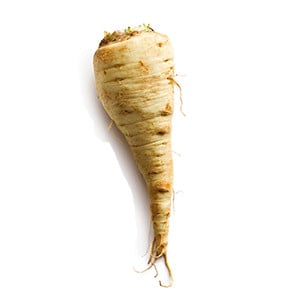Parsnip

Parsnip
Pastinaca sativa
Plant family
Umbellifers (Apiaceae)
Cultivation Break
4 Years
Season Overview
Sowing
Harvest
J
F
M
A
M
J
J
A
S
O
N
D
Details
Light requirement
Semi-shaded
Water requirement
Moist
Soil
Medium (loamy)
Nutrient requirement
Medium
Dark germinator
Germination temperature
12 - 18 °C (Degrees Celsius)
Plant distance
15 cm
Row spacing
30 cm
Seeding depth
1.5 cm
Instructions
The season for this plant has not yet begun. The following instructions are for the beginning season.
Beginning of March
Sowing
Beginning of March
Weeding
Every week
End of March
Pest protection
Description
Like the carrot, the parsnip is a biennial crop from the umbelliferae family. However, when grown as a vegetable, it is harvested in the first year. This is because in the second year it flowers and the root is then no longer edible. The turnips are yellowish-white and take a long time to grow to harvest maturity. Parsnip is a very old vegetable, which was almost forgotten. Therefore, there are only a few varieties.
Origin:
Eastern Mediterranean
Growing tips
In cool temperatures, it is recommended to cover the plants with fleece. For young plants, regular weed control is necessary. In summer, the plants need a good water supply, as they form a lush foliage. Before harvesting, it is useful to loosen the soil to make it easier to pull the roots out of the ground. Covering the soil with straw or fleece facilitates harvesting, as this prevents the soil from freezing.
Companion Plants
Antagonistic Plants
Diseases
Downy mildew
Angular leaf spot of cucumber
Black spot of roses
Red spot disease
Pests
Land snails
Voles